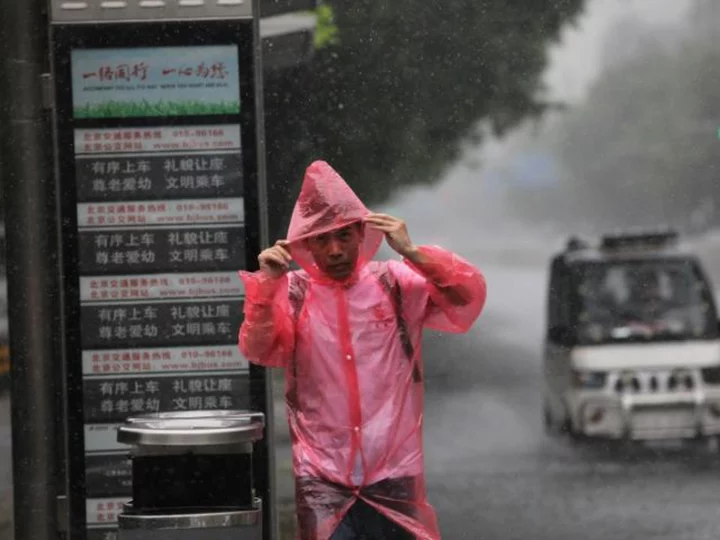Tens of thousands of people fled their homes in Beijing after Typhoon Doksuri, one of the strongest storms in years, dumped torrential rain across China as forecasters warned another hurricane-level storm was on its way.
China is reeling from extreme weather events this summer, much like much of the world. Heat waves scorched China earlier than usual this year while records have been set worldwide for global temperatures, ocean heat and the loss of sea ice.
Doksuri hurtled into the southeastern coastal province of Fujian late last week, weakening as it carved its way north but bringing huge amounts of rain to at least five northern Chinese provinces since Saturday.
More than 31,000 people were evacuated from the Chinese capital as of Sunday night, state broadcaster CCTV reported. Another half million people in the southern province of Fujian were forced to evacuate from flooding, state news agency Xinhua reported.
The storm killed two and another two went missing while mushroom picking in northeastern Liaoning province, CCTV reported.
The precipitation in Beijing could break records as nearly 40 inches of rain is projected to pour over the southwestern parts of the capital and neighboring Hebei province, according to the China Meteorological Administration on Monday.
Heavy downpours are expected to continue through Tuesday, increasing concerns about dangerous flooding and landslides.
On Monday, nine districts of Beijing were under a red rainstorm alert, the highest in the country's warning mechanism, while the weather signal was downgraded to the second-highest level in other parts. At least 95 other weather warnings were issued across the country.
The intense downpours prompted the temporary closure of several railroads and highways in the capital, while schools also remained closed and people were told to stay indoors.
Doksuri is the most powerful typhoon to make landfall in China and the strongest storm to hit Fujian since Typhoon Saomi in 2006, according to CNN Weather based on preliminary information. The closest and most powerful storm to pass near Beijing was Rita back in 1972.
Before hitting Fujian it had killed at least 39 people in the Philippines and lashed parts of southern Taiwan.
The rains inundated large swathes of farmland and homes in Fujian costing nearly $60 million ($428 million yuan) in direct economic losses, Xinhua reported. More than 6,333 hectares of farmland in Fujian were damaged and over 151 hectares suffered complete crop failure, the state media outlet said.
And there is little relief on the horizon. Even as Doksuri tapers off, authorities are preparing for incoming Khanun, the sixth typhoon projected to hit China this year.
Forecasters expect storm tides to hit coastal areas of Zhejiang from Monday to Thursday as Typhoon Khanun draws closer, prompting local authorities to activate the lowest out of a four-tier emergency response level on Monday, Xinhua reported.
Khanun is gathering strength in the Pacific Ocean and has been upgraded to a Category 3-equivalent typhoon by the Joint Typhoon Warning Center. It's forecast to draw close to Japan's southern Okinawa islands over the next two days and begin a slow crawl through the East China Sea.
Over 200 domestic flights to and from Naha, Miyako, and Ishigaki islands in Okinawa were canceled from Monday through Wednesday, affecting nearly 30,000 passengers.
Extreme weather in Asia
Asia, the world's largest and most populous continent, is reckoning with the deadly effects of extreme summer weather, as countries endure blistering heatwaves and record monsoon rains.
While most of northeastern China is inundated by rainfall, the neighboring Korean peninsula is suffering from deadly heat waves.
At least 10 people have died from heat-related illnesses as South Korea swelters under a heat wave that has brought its highest temperatures so far this year to parts of the country, according to data released Sunday by the Korea Disease Control and Prevention Agency (KDCA).
Just two weeks ago, torrential rain in South Korea killed at least 41 people from landslides and flash floods, including at least 13 dead from a flooded underpass that trapped vehicles in the deluge.
This weekend, a total of 1,015 people suffered heat-related diseases, which the KDCA defines as heat stroke, heat exhaustion, heat cramps, heat syncope and heat edema.
More than a quarter of those affected by the heat were aged 65 years and older, while around 20% were aged between 50 and 59.
More than a third of the cases were reported from people working outside and around 14% were reported on farmland, it added.
Since late July, heat wave warnings have expanded to most of the country with temperatures soaring over the weekend to between 33 and 39 degrees Celsius (between around 91 to 102 degrees Fahrenheit).
On Saturday, a number of cities reported their highest daily temperatures so far this year. The city of Gyeongju saw temperatures reach 36.8 degrees Celsius (98.24 Fahrenheit) and Jeongseon county saw temperatures reach 36.1 Celsius (96.98 Fahrenheit), according to the Korea Meteorological Administration.
Seoul's affluent Gangnam district saw temperatures reach to 35.7 degrees Celsius (around 96.2 Fahrenheit), while North Gyeongsang Province saw temperatures reach 38.1 degrees Celsius (100.58 degrees Fahrenheit).
A heat wave warning remains in effect on Monday, which signals daily maximum temperatures are expected to be 35 degrees Celsius or higher for more than two consecutive days.

